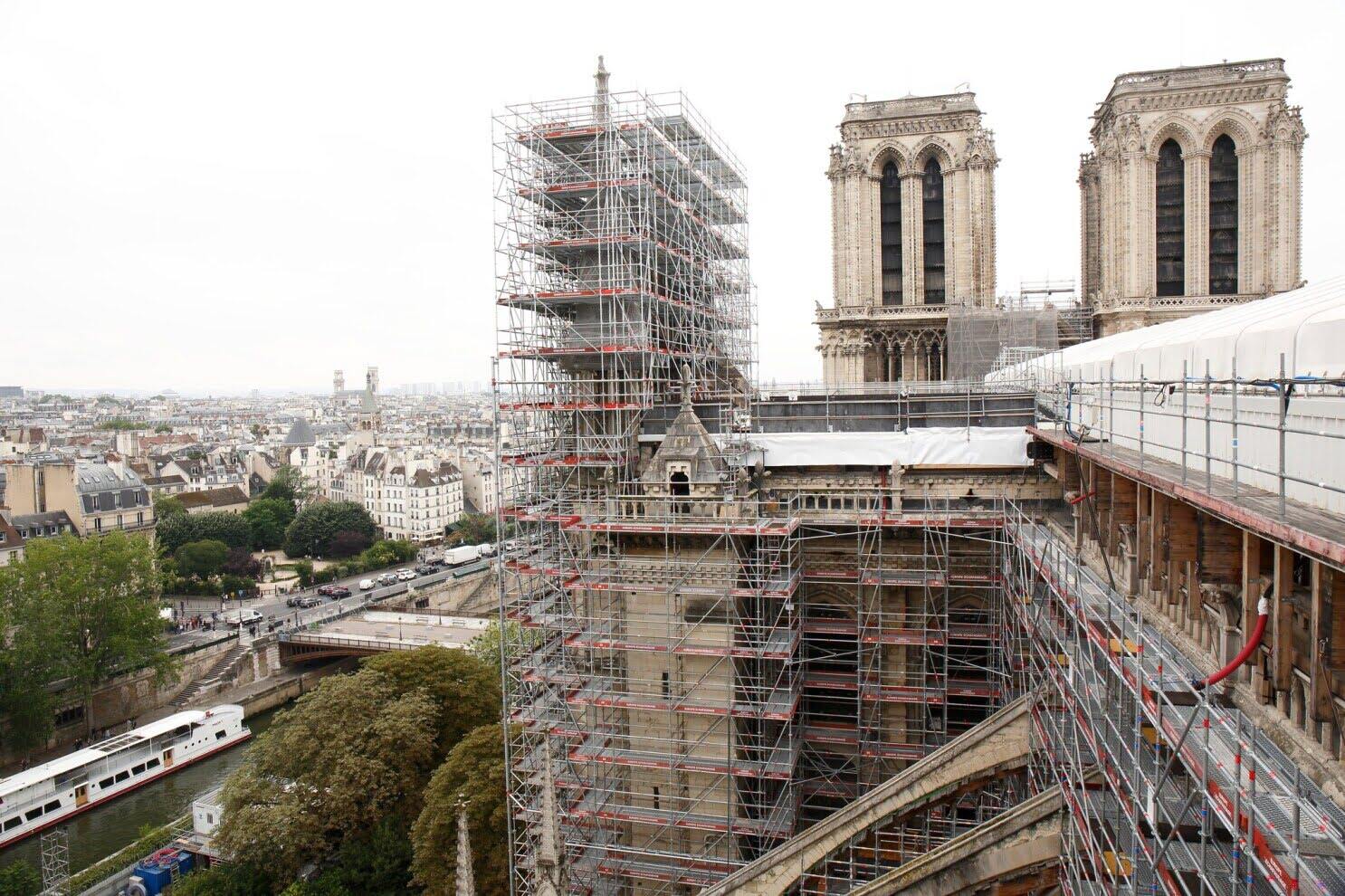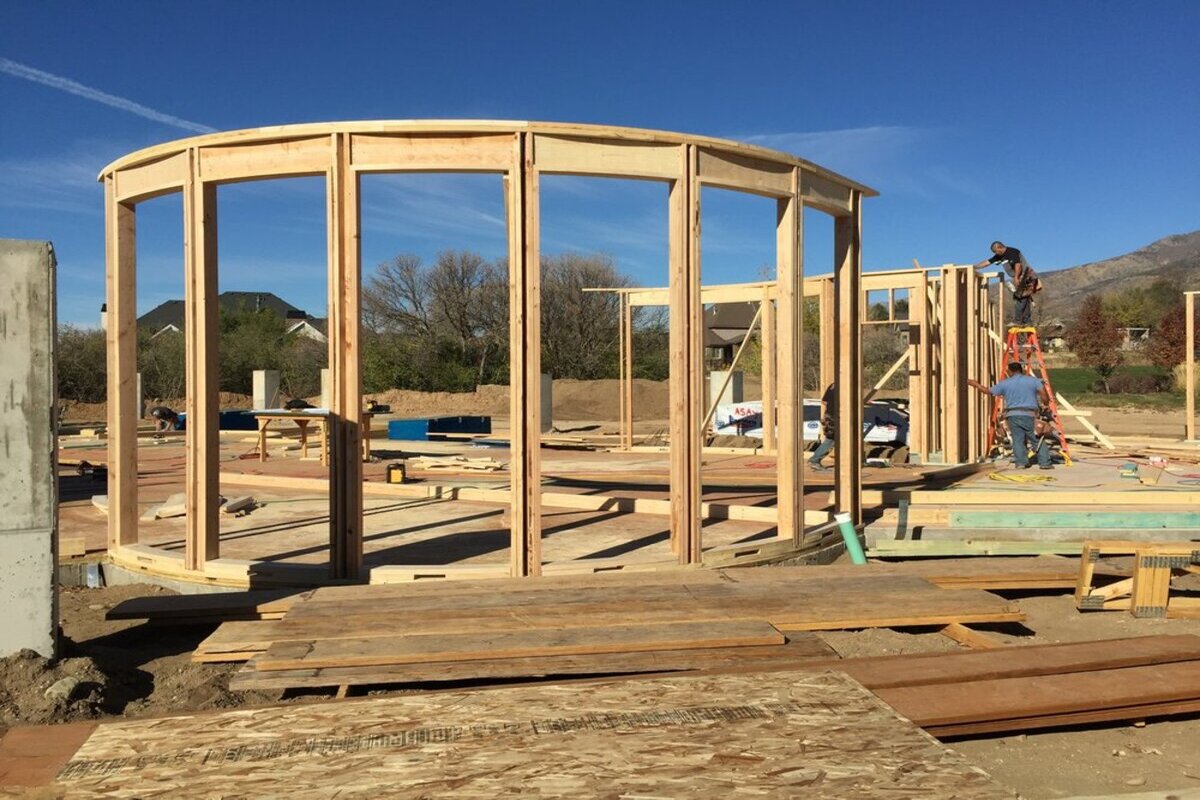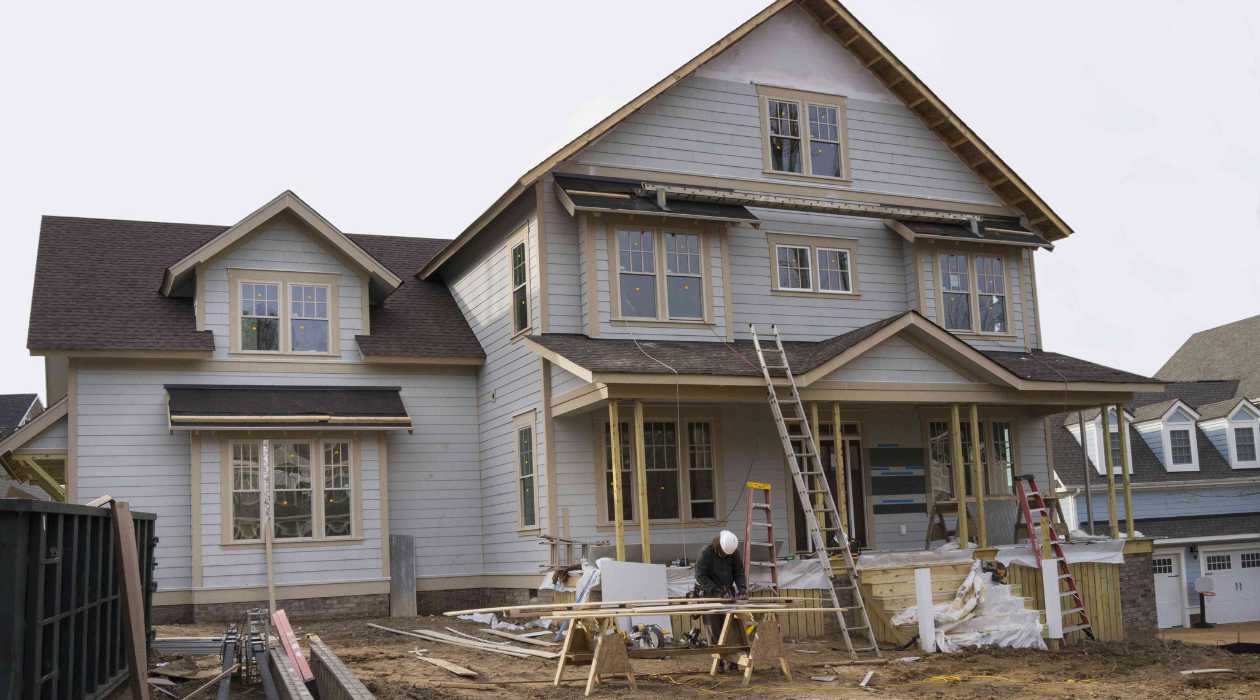Home>diy>Home Improvement>How Is The Renovation Of Notre Dame Progressing


Home Improvement
How Is The Renovation Of Notre Dame Progressing
Modified: October 19, 2024
Discover the latest updates on the ongoing renovation of Notre Dame and learn how this iconic architectural project is progressing. Explore the intriguing world of home improvement with us!
(Many of the links in this article redirect to a specific reviewed product. Your purchase of these products through affiliate links helps to generate commission for Storables.com, at no extra cost. Learn more)
Introduction
The Notre Dame renovation project, which began in 2019, is a monumental undertaking to restore and revitalize one of the world’s most iconic landmarks, the Notre Dame Cathedral in Paris, France. The cathedral holds immense cultural, historical, and religious significance, attracting millions of visitors each year.
On April 15, 2019, the world watched in horror as a devastating fire engulfed the Notre Dame Cathedral, causing significant damage to its roof and spire. The incident not only shook Paris, but also reverberated around the globe, sparking an outpouring of support and a collective determination to restore this architectural masterpiece.
The Notre Dame Cathedral, with its Gothic architecture dating back to the 12th century, is not only a religious symbol but also an integral part of French history and culture. It has witnessed pivotal moments, including coronations, weddings, and funerals of kings and prominent figures. The cathedral’s grandeur and intricate design, featuring majestic stained glass windows, flying buttresses, and gargoyles, have captivated the imaginations of people for centuries.
The renovation project aims to honor and preserve the rich history and cultural heritage of Notre Dame, ensuring that future generations can continue to marvel at its beauty. This immense undertaking encompasses not only the physical restoration of the cathedral but also the protection of its historical significance and the engagement of the community in the process.
With a project of this magnitude, careful planning and execution are crucial. Architects, historians, engineers, artisans, and a range of experts have come together to meticulously assess the damage, develop restoration plans, and implement measures to ensure the structural stability and long-term preservation of the cathedral.
The Notre Dame renovation project also presents an opportunity to incorporate innovative approaches and technologies while staying true to the original architecture and craftsmanship. It serves as a testament to human ingenuity and determination to restore and protect our shared cultural heritage.
As the project progresses, it serves as a reminder of the resilience of the human spirit and our collective responsibility to safeguard historical landmarks. The restoration of the Notre Dame Cathedral embodies the commitment of individuals, organizations, and governments to come together and rebuild not only a physical structure but also a symbol of hope, beauty, and unity.
Key Takeaways:
- The restoration of Notre Dame Cathedral showcases global solidarity in preserving cultural heritage, emphasizing the significance of public engagement and innovative strategies in overcoming challenges for monumental restoration projects.
- The completion of the Notre Dame Cathedral’s restoration will not only reinstate its architectural magnificence but also serve as a symbol of resilience, hope, and unity, inspiring future preservation efforts worldwide.
Initial Damage Assessment
Following the devastating fire at the Notre Dame Cathedral, a comprehensive assessment was conducted to determine the extent of the damage and identify the structural vulnerabilities that needed to be addressed during the renovation process.
The fire, which ravaged the cathedral for several hours, caused significant damage to the wooden roof and spire, resulting in their collapse. The intense heat and flames also damaged parts of the stone vaults and caused the weakening of some structural elements.
Initial assessments revealed that approximately two-thirds of the roof and one-third of the interior wooden structure were destroyed by the fire. The spire, an iconic feature of the cathedral, completely collapsed, leaving behind only charred remnants.
While the stone exterior walls remained largely intact, they suffered from heat-induced cracks, water damage from firefighting efforts, and the weakening of the stone joints. These vulnerabilities required careful examination to ensure their stability and integrity.
Another significant area of concern was the stained glass windows, which had been exposed to extreme heat, causing damage and potential weakening of the leaded glass panels. These delicate and intricate features required meticulous inspection and specialized restoration techniques.
Furthermore, the timber framework that supported the roof and structure was extensively damaged, necessitating a thorough evaluation of its stability. The restoration team needed to determine the extent of the damage and develop a plan to rebuild or reinforce the wooden elements.
Understanding the extent of the fire damage and identifying each structural vulnerability was crucial before formulating the restoration plan. This assessment formed the foundation for the subsequent steps taken to stabilize the cathedral and commence the restoration process.
The initial damage assessment highlighted the challenges that lay ahead for the renovation team. It emphasized the need for a multidisciplinary approach, bringing together architects, structural engineers, restoration specialists, and craftsmen to address the diverse range of issues and ensure the successful restoration of the Notre Dame Cathedral.
Stabilization Efforts
Following the devastating fire at the Notre Dame Cathedral, immediate steps were taken to secure the structure and prevent further damage. These stabilization efforts were crucial in ensuring the stability and safety of the cathedral throughout the restoration process.
One of the first tasks undertaken was the installation of temporary protective measures to safeguard the exposed areas of the cathedral. Tarpaulins and scaffolding were erected to shield vulnerable sections from rain, wind, and potential further deterioration. This temporary covering served to minimize additional damage caused by the elements and provided a controlled environment for subsequent restoration work.
The stabilization process also involved conducting thorough examinations to identify potential risks and challenges. Structural engineers meticulously assessed the remaining parts of the cathedral, focusing on the stability of the stone walls, vaults, and supporting columns. They examined the impact of the fire on the integrity of these elements, identifying areas that required reinforcement or restoration.
One of the significant risks identified during the examination was the potential instability of the remaining stone vaults. These vaults play a crucial role in distributing the weight of the structure and keeping the cathedral intact. Any compromised vaults had to be carefully addressed to avoid any further collapse or structural deterioration.
Additionally, the restoration team identified the importance of addressing water damage caused by firefighting efforts. Water infiltration can lead to long-term structural issues, such as weakened masonry and the proliferation of mold. It was imperative to implement measures to dry out the affected areas and apply treatments to mitigate the risk of moisture-related problems.
Throughout the stabilization phase, regular monitoring and assessments were conducted to evaluate the stability of the structure and address any emerging issues promptly. Advanced structural monitoring techniques, including sensors and drones, were utilized to monitor movement, vibrations, and structural integrity.
The Notre Dame restoration project faced numerous challenges, including the risk of further collapse, potential structural instability, and the need for delicate intervention to mitigate the impact of the fire and subsequent damage. However, through meticulous planning, expertise, and ongoing monitoring, the stabilization efforts helped establish a secure foundation for the restoration works to come.
By addressing the immediate risks and challenges, the restoration team ensured that the Notre Dame Cathedral remained safe and protected throughout the reconstruction process. These stabilization efforts laid the groundwork for the next phase: comprehensive restoration planning and execution.
Restoration Planning
In the aftermath of the devastating fire at the Notre Dame Cathedral, meticulous restoration planning was undertaken to guide and execute the comprehensive renovation project. The restoration planning phase involved the formation of restoration teams and committees, as well as the establishment of clear goals and objectives.
One of the key steps in the planning process was the formation of specialized restoration teams comprising experts from diverse fields. Architects, structural engineers, historians, conservators, craftsmen, and artists came together to lend their expertise to various aspects of the project.
These teams played a crucial role in conducting detailed assessments, developing restoration strategies, and overseeing the implementation of the restoration works. Collaboration between these diverse disciplines ensured a holistic approach to the project, taking into account the historical significance, architectural integrity, and cultural value of the Notre Dame Cathedral.
Moreover, committees were set up to provide guidance and oversee the restoration process. These committees included representatives from the French government, the Catholic Church, heritage preservation organizations, and other stakeholders. Their involvement ensured transparency, adherence to best practices, and effective decision-making throughout the project.
Another essential component of the restoration planning phase was outlining the restoration goals and objectives. The primary objective was to restore the cathedral to its pre-fire magnificence while ensuring the preservation of its historical and cultural value.
The restoration goals encompassed the following key aspects:
- Preserving the original architectural features: The restoration aimed to retain the architectural integrity of the Notre Dame Cathedral, ensuring that the original design and craftsmanship were faithfully preserved. This involved meticulous documentation, analysis of surviving elements, and the use of traditional techniques and materials where possible.
- Strengthening the structure: The restoration project sought to address the vulnerabilities identified during the initial damage assessment. Strengthening the stone walls, vaults, and supporting structure was paramount to ensure the long-term stability and safety of the cathedral.
- Reconstructing the roof and spire: The iconic roof and spire, lost in the fire, were to be reconstructed in a manner that respected the original design while incorporating modern safety measures and techniques.
- Conserving and restoring stained glass windows: The delicate stained glass windows, some of which date back centuries, were carefully restored to their former glory. This involved cleaning, repairing damaged sections, and protecting them from future deterioration.
- Engaging in responsible restoration: Every effort was made to ensure that the restoration process was sustainable, adhering to ethical practices. This included using eco-friendly materials, energy-efficient systems, and minimizing waste generation.
The restoration planning phase provided a clear roadmap for the subsequent stages of the project. It set the foundation for the meticulous and sensitive restoration works that would be carried out over the coming years, with the ultimate goal of reviving the architectural masterpiece that is the Notre Dame Cathedral.
Architectural and Engineering Considerations
Restoring the Notre Dame Cathedral requires careful architectural and engineering considerations to ensure the structural integrity of the building and the preservation of its historical features. This involves a comprehensive assessment of the existing structure and the evaluation of materials and techniques for restoration.
One of the primary objectives of the restoration project is to assess the structural integrity of the Notre Dame Cathedral. Structural engineers conduct detailed inspections and investigations to identify any weaknesses, cracks, or damage caused by the fire. Through advanced techniques such as laser scanning and computer modeling, they analyze the existing structure and assess its load-bearing capacity.
Based on the assessments, engineers develop strategies to reinforce the weakened areas of the cathedral. This may involve the installation of additional support systems, such as steel reinforcements or carbon fiber composites, to enhance the structural stability while minimizing visual impact on the original architecture.
Another crucial aspect of architectural and engineering considerations is the evaluation of materials and techniques for restoration. Restoration experts research and analyze historical records, architectural drawings, and photographic evidence to understand the original construction methods and the materials used in the construction of the cathedral.
When it comes to restoration, the goal is to adhere to the authenticity and integrity of the original building. Consequently, the use of original materials or close replicas is favored wherever possible. Traditional techniques that align with the craftsmanship of the original builders are also emphasized.
With advancements in technology and construction practices, modern materials and techniques can be integrated into the restoration process. However, it is important to strike a balance between incorporating contemporary innovations for improved durability and safety while maintaining the historical accuracy and aesthetic character of the cathedral.
Restoration teams collaborate with craftsmen and artisans skilled in traditional techniques to recreate intricate details, ornamental elements, and decorative features of the cathedral. This includes the replication or repair of gargoyles, sculptures, and other architectural embellishments that were damaged or lost in the fire.
Alongside the materials and techniques for structural restoration, the conservation and restoration of the stained glass windows present another significant challenge. Each stained glass panel requires delicate and precise attention, ensuring the cleaning, repair, and stabilization of the leaded glass and its intricate designs.
The architectural and engineering considerations in the Notre Dame Cathedral restoration project reflect the delicate balance between preserving the historical significance of the building and incorporating necessary modern interventions. The aim is to achieve a seamless integration of traditional craftsmanship and contemporary expertise to ensure the long-term preservation of this iconic landmark.
Read more: How To Store A Puzzle In Progress
Fundraising and Financial Support
The restoration of the Notre Dame Cathedral is a colossal undertaking that requires significant financial resources. A wide-ranging fundraising campaign was launched to garner support and secure the necessary funds for the restoration project. The campaign witnessed contributions from individuals, organizations, and governments around the world.
The fundraising campaign for the Notre Dame restoration project quickly gained global attention and support. It served as a testament to the universal admiration and appreciation for the cultural, historical, and architectural significance of the cathedral.
Various organizations and philanthropic entities actively participated in the fundraising efforts. Cultural heritage and preservation organizations, both national and international, stepped forward to offer financial contributions and expertise to ensure the successful restoration of the Notre Dame Cathedral.
In addition to institutional contributions, a significant amount of funds were generated from individual donations. People from all walks of life, motivated by their personal connection to the Notre Dame Cathedral or by a desire to preserve cultural heritage, eagerly contributed to the restoration campaign.
The outpouring of support was not confined to France alone. Governments from around the world pledged financial assistance as a recognition of the global significance of Notre Dame. These contributions reflected the sense of solidarity and shared responsibility in safeguarding humanity’s collective heritage.
Alongside financial donations, fundraising efforts took various forms. Benefit concerts, charity auctions, crowdfunding campaigns, and other events were organized to raise funds and engage the public in the restoration project. These initiatives not only generated financial support but also fostered a sense of community involvement and ownership.
The significant monetary contributions and widespread support received for the restoration of Notre Dame demonstrated the immense global reverence for this iconic landmark. The generosity of individuals, organizations, and governments alike has played a vital role in ensuring the financial viability and progress of the restoration project.
The focus on transparency and accountability in the fundraising campaign has been essential. Oversight committees, comprising representatives from various stakeholders, were established to ensure that the funds are allocated and utilized effectively and efficiently. Regular financial reporting and auditing procedures were implemented to provide transparency to the donors and the general public.
While the initial fundraising efforts have been successful in generating substantial financial support, continued fundraising will be a crucial aspect of the restoration project. The long-term sustainability of the project relies on securing sufficient funds to complete the restoration in its entirety and to maintain the cathedral for future generations.
The collective financial support for the Notre Dame restoration project serves as a testament to the universal reverence for the cathedral and the recognition of its significance as a cultural and historical treasure. It highlights the commitment of individuals, organizations, and governments worldwide to preserve and protect our shared heritage.
Stay updated on the renovation progress of Notre Dame by following official announcements from the French government and the Notre Dame Cathedral website. Look for reputable news sources for the latest information.
Key Milestones Achieved
The renovation process of the Notre Dame Cathedral has been a complex and meticulous endeavor, marked by several major milestones and notable accomplishments. The restoration efforts have progressed through various stages towards the ultimate goal of revitalizing this iconic landmark.
One of the important early milestones was the stabilization of the structure, ensuring the safety and security of the cathedral. Immediate measures were taken to protect the exposed areas, install temporary covering, and secure the vulnerable sections. This stabilization phase laid the foundation for subsequent restoration works.
Throughout the restoration process, significant progress has been made in assessing and repairing the structural damage caused by the fire. Experts meticulously evaluated the remaining stone walls, vaults, and supporting columns, reinforcing and repairing them where necessary to ensure their stability and durability.
A notable accomplishment in the restoration efforts was the successful removal of the damaged scaffolding that had been left in place during the fire. The removal of this hazardous structure was a meticulous and delicate operation that required careful planning and execution to ensure the safety of the cathedral and the restoration team.
Another significant milestone was the restoration of the iconic stained glass windows. Skilled craftsmen and conservators painstakingly cleaned, repaired, and stabilized the intricate glass panels, bringing back their vibrant colors and intricate patterns. The restoration of these windows has not only preserved their historical and artistic value but has also enhanced the overall visual experience of the cathedral.
The reconstruction of the roof and spire has been a major focus of the restoration efforts. Craftsmen, architects, and engineers have worked diligently to recreate these architectural elements, incorporating modern techniques and technologies while respecting the original design. This reconstruction represents a remarkable achievement in restoring the grandeur and identity of the Notre Dame Cathedral.
Notably, the ongoing restoration project has also embraced innovation and digital technology. Advanced techniques, such as laser scanning, 3D modeling, and virtual reality, have been employed to aid in the documentation, analysis, and visualization of the cathedral’s intricate details. These technological advancements have enhanced the efficiency and precision of the restoration works.
Additionally, the restoration efforts have garnered increased public engagement and awareness. The Notre Dame Cathedral has become a symbol of resilience, sparking interest and support from people around the world. The inclusion of the public in the restoration process through educational programs, virtual tours, and public consultations has created a sense of ownership and pride in preserving this cultural treasure.
As the restoration project progresses, each milestone achieved brings the Notre Dame Cathedral closer to its former glory. These notable accomplishments not only demonstrate the remarkable progress made in the renovation process but also symbolize the dedication, expertise, and collaborative efforts of the restoration teams involved.
The restoration of the Notre Dame Cathedral stands as a testament to our collective commitment to preserve and safeguard our shared cultural heritage, ensuring that future generations can continue to marvel at its magnificence and appreciate its historical significance.
Challenges and Setbacks
The renovation of the Notre Dame Cathedral has not been without its fair share of challenges and setbacks. The restoration efforts have encountered unexpected obstacles throughout the process, requiring the implementation of innovative strategies to overcome these difficulties.
One of the most significant challenges during the renovation was the discovery of lead contamination in the vicinity of the cathedral. The fire had released toxic lead particles from the roof and spire, posing a potential health risk to workers and the surrounding environment. This necessitated the implementation of strict safety measures and decontamination protocols to mitigate the risk and ensure the well-being of everyone involved in the restoration project.
Another obstacle faced during the restoration was the identification of hidden structural issues that were not immediately apparent. As the restoration teams delved deeper into the examination of the building, they encountered unexpected weaknesses and vulnerabilities in certain sections. These discoveries required swift adaptation and the development of new strategies to reinforce and stabilize the affected areas, ensuring the long-term integrity of the cathedral.
Additionally, the COVID-19 pandemic presented an unforeseen challenge to the restoration project. The restrictions and safety protocols imposed to contain the spread of the virus affected the progress of the renovation works. Work had to be temporarily halted, and strict health and safety measures had to be put in place to protect the workers and minimize disruptions to the project timeline. Despite the setbacks caused by the pandemic, the restoration efforts resumed as soon as it was safe to do so, with adjustments made to ensure the continued progress of the project.
Strategies implemented to address these challenges included collaboration with experts from various fields, such as lead remediation specialists, environmental consultants, and health professionals. By drawing on the expertise of these professionals, the restoration teams were able to develop and implement comprehensive plans to tackle lead contamination, ensuring the safety of the workers and the community.
To address the hidden structural issues, engineers and architects adapted their plans and methods to reinforce and stabilize the compromised areas. These modifications involved employing innovative engineering techniques, such as carbon fiber reinforcements and advanced monitoring systems, to ensure the long-term stability of the cathedral.
Communication and coordination among the various stakeholders, including the restoration teams, government bodies, and heritage organizations, played a crucial role in navigating the challenges and setbacks. Regular meetings, updates, and consultations allowed for effective problem-solving and decision-making, ensuring the smooth progression of the restoration project despite unforeseen obstacles.
Despite the challenges faced during the renovation process, the commitment to restoring the Notre Dame Cathedral remained unwavering. The dedication, expertise, and resilience of the restoration teams and their ability to adapt and overcome difficulties have been instrumental in ensuring the successful continuation of the restoration efforts.
By addressing unexpected obstacles and implementing innovative strategies, the restoration project remains on track to bring the Notre Dame Cathedral back to its former glory while preserving its historical, cultural, and architectural significance.
Community Involvement and Public Engagement
The restoration of the Notre Dame Cathedral has embraced community involvement and public engagement as essential components of the project. Recognizing the significance of the cathedral to both locals and people around the world, initiatives have been undertaken to engage the public in the restoration project and educate the local community about its importance.
One of the aims of the restoration project is to ensure that the public feels a sense of ownership and connection to the Notre Dame Cathedral. To achieve this, initiatives have been launched to actively engage the public throughout the restoration process. Virtual tours, interactive exhibits, and online platforms allow individuals from all over the world to experience the cathedral’s beauty and learn about its history and significance. These digital engagements foster a sense of participation and encourage support for the restoration efforts.
Local community involvement has also been a priority in the restoration project. Regular community meetings and consultations are held to provide updates on the progress, address concerns, and gather feedback from the residents living in the vicinity of the cathedral. This open line of communication enables the project organizers to take into account the opinions and needs of the community, ensuring a collaborative approach to the restoration process.
Education plays a crucial role in raising awareness about the Notre Dame Cathedral’s historical and cultural significance. Educational programs have been developed to provide insights into the cathedral’s architecture, art, and history. This includes partnerships with schools, universities, and cultural institutions to offer educational materials, workshops, and lectures focused on the cathedral and its restoration. By fostering a deeper understanding of Notre Dame’s importance, these initiatives inspire a sense of stewardship and cultural responsibility among the younger generation.
Furthermore, initiatives to foster the development of traditional craftsmanship and restoration techniques have been undertaken. Apprenticeship programs and workshops offer opportunities for aspiring craftsmen and artisans to learn and develop their skills under the guidance of experienced professionals. This commitment to preserving and passing on traditional craftsmanship ensures the availability of skilled artisans for the ongoing maintenance and future restoration of the Notre Dame Cathedral.
The Notre Dame Cathedral restoration project has also become a platform for international collaboration and knowledge exchange. Experts, researchers, and restoration professionals from around the world come together to share their expertise, best practices, and innovative approaches to cultural heritage preservation. This global cooperation not only enriches the restoration process but also promotes international understanding and cooperation.
By engaging the public and involving the local community in the restoration project, the aim is to instill a sense of pride, ownership, and responsibility for preserving this extraordinary historical monument. The involvement and support of the community ensure that the restoration of the Notre Dame Cathedral becomes an inclusive, transparent, and collaborative effort, reflecting the value that society places on its cultural heritage.
Read more: How To Monitor Construction Work Progress
Future Outlook
The restoration of the Notre Dame Cathedral is a project that combines historical preservation, craftsmanship, and architectural excellence. While the restoration process is complex and time-consuming, there is optimism for the future as the project progresses towards completion. The anticipated timeline and the expected impact of the renovated Notre Dame Cathedral are of great interest to people around the world.
Given the enormity of the restoration project and the need for meticulous craftsmanship, an estimated timeline has been outlined for the completion of the restoration. The restoration works are expected to span several years, with the goal of completing the project in the next decade. However, it is important to note that the timeline could be subject to adjustments based on unforeseen challenges and the ongoing commitment to preserving the cathedral’s historical integrity.
The anticipated impact of the renovated Notre Dame Cathedral is significant on multiple levels. On a cultural and historical level, the completion of the restoration will reinstate one of the most iconic landmarks and symbols of France and humanity’s architectural achievements. The meticulous attention to detail and adherence to the original design will resurrect the grandeur and beauty of the cathedral, allowing visitors to experience the historical and cultural significance firsthand.
The renovated Notre Dame Cathedral is expected to become a symbol of resilience and hope. Its restoration will serve as a testament to humanity’s ability to overcome adversity and safeguard our shared cultural heritage. As one of the world’s most recognizable landmarks, the cathedral’s renewed presence will reinvigorate tourism and promote cultural tourism in Paris, attracting visitors from around the globe.
Moreover, the renovation of Notre Dame will have a far-reaching legacy beyond its physical transformation. The restoration project sheds light on the importance of preserving historical and architectural treasures for future generations. It serves as a reminder of humanity’s responsibility to protect and value our cultural heritage, prompting similar preservation efforts for other iconic landmarks around the world.
The completion of the restoration project will also provide opportunities for ongoing research and technological advancements. The meticulous documentation, analysis, and restoration techniques developed during the process can contribute to a broader understanding of historical architecture and restoration practices. This knowledge can be shared with the global community, further promoting the preservation of cultural heritage.
The renovated Notre Dame Cathedral will continue to serve as a place of worship, a hub of cultural activities, and a symbol of unity for the local community. It will host religious services, concerts, and events that bring together people from different backgrounds and beliefs, fostering a sense of community and collective identity.
Looking to the future, the completion of the restoration of the Notre Dame Cathedral will mark a triumph of conservation, artistry, and human dedication. It will stand as an enduring beacon of beauty, resilience, and cultural significance that serves as a reminder of our shared history and the enduring power of architectural masterpieces.
Conclusion
The renovation of the Notre Dame Cathedral is an ambitious and intricate undertaking that has made significant progress since the devastating fire in 2019. Through meticulous planning, international collaboration, and the dedication of restoration teams, the project has reached notable milestones in the revitalization of this iconic landmark.
From the initial damage assessment to the stabilization efforts and the development of restoration plans, the renovation project has demonstrated a commitment to preserving the historical and cultural significance of the Notre Dame Cathedral. Significant structural repairs and the restoration of stained glass windows have breathed new life into this architectural masterpiece.
Fundraising efforts and contributions from all corners of the world have exemplified the global reverence for the cathedral and a shared responsibility to protect our collective heritage. The project has garnered public engagement through digital initiatives and educational programs, creating a sense of ownership and pride in preserving the Notre Dame Cathedral.
Despite challenges and setbacks, such as lead contamination, hidden structural issues, and the impact of the COVID-19 pandemic, the restoration efforts have persevered. Strategies have been implemented to address these obstacles, ensuring the safety of workers and the preservation of the cathedral’s integrity.
Looking to the future, an estimated timeline has been set for the completion of the restoration. As the project progresses, the renovated Notre Dame Cathedral is anticipated to have a profound impact. It will serve as a symbol of resilience, hope, and unity and reestablish itself as one of the world’s most renowned cultural landmarks.
Moreover, the renovation of the Notre Dame Cathedral underscores the importance of preserving historical landmarks for future generations. It serves as a reminder of the value and significance of cultural heritage, highlighting our responsibility to protect and cherish these remarkable treasures of human history.
As the restoration project nears its completion, the world eagerly anticipates the renaissance of the Notre Dame Cathedral. It will stand not only as a testament to the unwavering human spirit and determination but also as a reminder of the enduring legacy of architectural masterpieces and their significance in shaping our collective identity.
The restoration of the Notre Dame Cathedral is a testament to the power of restoration, preservation, and collaboration. It reinforces the timeless importance of safeguarding our cultural heritage, encouraging us to cherish and protect historical landmarks for generations to come.
Frequently Asked Questions about How Is The Renovation Of Notre Dame Progressing
Was this page helpful?
At Storables.com, we guarantee accurate and reliable information. Our content, validated by Expert Board Contributors, is crafted following stringent Editorial Policies. We're committed to providing you with well-researched, expert-backed insights for all your informational needs.














0 thoughts on “How Is The Renovation Of Notre Dame Progressing”